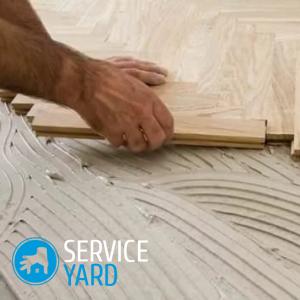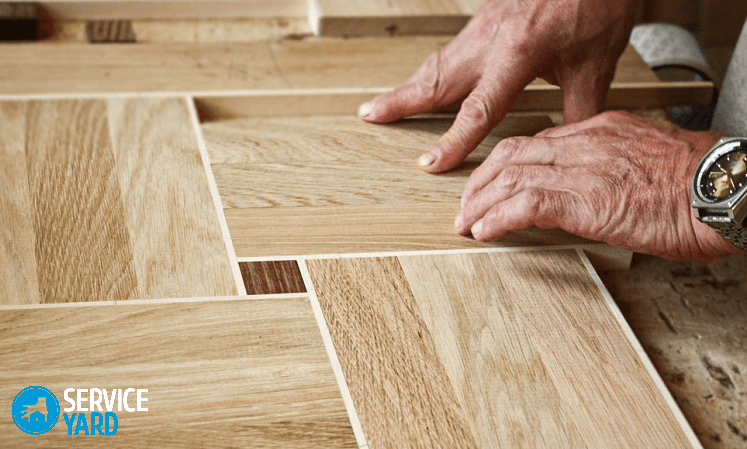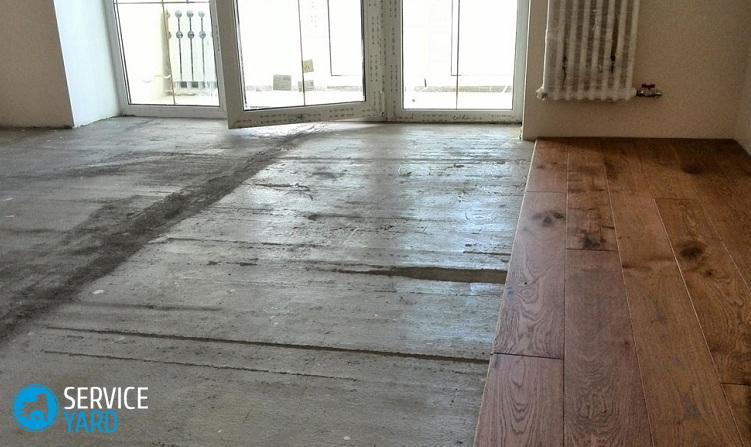Concrete screed for parquet

There are several ways to lay parquet flooring. With the creation of new materials, some traditional, labor-intensive methods have lost relevance. However, laying parquet on a concrete screed is still popular today. It is distinguished by durability and quality factor. The topic of today's article is glue for parquet on a concrete screed and the algorithm for its use. The installation technology of the coating is quite simple, so you can implement it without contacting specialists.
to contents ↑Specifics of work
Parquet board, like any wood, is not particularly moisture resistant, therefore:
- Mount it after all the whitewashing and painting work has already been completed.
- The optimum temperature in the room is 22-24 degrees, the humidity range is from 40 to 60 percent.
Important! If the air is too dry, the dies crack and warp. In rooms with high humidity, the floors swell, which is also fraught with deformations of the floor.
Laying parquet on a concrete screed - preparation for work
You will need these tools:
- Construction level.
- Knife.
- Hammer.
- Pencil, felt-tip pen or marker.
- The square.
- Roulette.
- Electric jigsaw.
From consumables you will need:
- Glue.
- Wedges made of wood.
- Self-tapping screws, dowels, nails.
Concrete screed - is it necessary?
Laying a parquet board directly on a concrete base is a rarity. Most often, the flooring is laid on a screed or wooden logs:
- If the height differences on the concrete base are not more than 20 mm, you can not use a concrete screed, using a self-leveling coating.
- With a difference of 2 cm, a concrete screed is used.
- Before pouring screeds, waterproof the floor using a reinforced, foil film or polyethylene. Waterproofing is used with a margin - the excess goes under the baseboard.
- The thickness of the screed with a height difference of 20 mm is 40 mm or more. The drying time of the screed is about 1.5 months.
Important! For example, it takes 1 to 1.5 months to solidify a 4-5 cm layer of screed. It takes twice as long to solidify a layer whose thickness exceeds 5 cm. The curing process should be natural. It is impossible to accelerate it with drafts or the use of fans, since the screed can break.
- The next step is the installation of a moisture-resistant plywood layer with a thickness of 1 to 1.8 cm. For the plywood to adhere well, you need to cut it into pieces of 750x450 mm or 400x400 mm in size.
- The interval between the individual pieces is from 3 to 5 mm, the distance from the wall is 10 mm.
- The gaps are filled with sealant, fasten the sheets on nails with dowels or screws.
Important! To avoid problems with grinding, you need to recess the heads of nails by 3-5 mm.
- After the plywood sheets are laid, it is necessary to let it rest for a couple of days, and then smooth the surface by grinding.
There is a technology for laying flooring and without the use of plywood. In order for a parquet board to be laid on a screed without plywood to be successful, you need good glue and a quality screed. In this case, the coating will serve no less than when laying a parquet board on a plywood base.
to contents ↑Glue laying algorithm:
- Glue is applied to the plywood base using a spatula.
- Parquet dies are applied to the surface with glue applied to it and they are shot with a pneumatic gun.
- At the end of the installation of the slats, it is necessary to withstand a technological break of about a week. This is necessary in order to remove excess moisture.
- Next is grinding and puttying the floor. Grinding makes it possible to level the surface, and putty eliminates microcracks.
Important! To putty does not stand out on the surface, it is mixed with wood dust, which was formed during grinding.
- An equally important step is the varnishing of the floor. It is necessary to apply varnish indoors without drafts, with the air conditioner turned off. The first layer of varnish penetrates the tree, soaking it. It allows you to maintain the original shade of wood and reduce further consumption of varnish. Before applying the varnish coating, the surface is ground again.
- The final stage is the installation of skirting boards. In addition to the decorative effect, the baseboard serves as a disguise for wiring, cables and small defects in the lower part of the walls. For fixing plinths, nails or self-tapping screws are used.
Screed adhesive for parquet board - a brief overview
Adhesive compositions are classified according to various criteria: one- and two-component, dispersion (on water), as well as synthetic (on solvents).
Dispersion
These are the most environmentally friendly compounds. They do not have a “chemical” smell. The disadvantage of dispersion adhesives is the limited area of use.
Important! Dispersion glue for parquet can be used if the board is made of moisture-resistant wood (larch, oak).
Synthetic
Unlike dispersion, the composition on solvents has a much wider area of use. Main components: synthetic resins and rubber.
The glue is fluid, it does not harden too quickly, so working with it is quite simple.
Important! The disadvantage is the strong “chemical” smell, which disappears after the glue dries.
Two-component
This is a polyurethane-based adhesive that is highly effective. Hardener is added to the adhesive mixture. This adhesive cures much faster than mixtures from the two previous categories.
Important! The disadvantage of a two-component composition is its high toxicity. You can work only with the use of protective equipment.
One component
This is a highly effective group of polymer-based adhesive mixtures. The main difference between single-component formulations is the absence of harmful and toxic substances.
to contents ↑Important! One drawback is the rather high cost.
What glue to choose to put the parquet on the concrete floor:
The choice of this or that type of adhesive composition depends on the selected technology, as well as on the specific type of work. Let's consider different cases in more detail.
Sticker plywood on the screed without fixing with screws
The main requirement here is high adhesion. Glue for parquet should provide good adhesion of plywood to concrete. Another point is high elasticity. This is necessary to absorb stress between the screed and plywood.
Important! The composition of the Berger Bond M1S brand meets these requirements best.
Bonding plywood sheets with self-tapping screws
Due to the fact that as an additional fastening, nails with dowels or self-tapping screws are used, the requirements for glue are not so strict. Self-tapping screws prevent deformation of plywood, so you can use a water-based composition, which is cheaper than a polyurethane counterpart.
Important! Experts recommend the dispersion composition of Jurgi (Yurga) from Austrian manufacturers.
Laying a parquet board on a screed without plywood base
If the parquet board dimensions 420x70 mm is made of moisture-resistant wood (ash or oak), then it is quite possible to use the Austrian structure of “Yurga”. Water does not penetrate to a depth that can lead to a change in the geometry of parquet boards. It should be remembered that the dispersion compositions harden more slowly than synthetic ones.Therefore, if you are limited in time, it is better to use the Berger Bond M1S.
Sticker for oak or ash flooring with pre-coated plywood
In this case, the task is as follows: mount the parquet board in such a way as to completely eliminate the risks of deformation. If the board warped, then on the finished coating it will be very noticeable.
Important! The best option, according to experts, is a two-component adhesive for Berger Bond P2S parquet.
Bonding parquet board varnished on both sides
In this case, it is important that the glue is as resistant to vertical tearing as possible. Testing parquet is mandatory, as there is a risk of tearing off the varnish.
Important! Best of all, Berger Bond P1 is a one-component polyurethane compound.
Installation of a parquet board from exotic wood without plywood coating
The same applies not only to exotic woods, but also to parquet boards made from maple, beech or cherry. Parquet in this case is very sensitive to changes in temperature and humidity. To avoid changing the geometry of the dies, you must use the composition without water.
Important! When installing parquet from unstable wood, Berger Bond P1 glue proved to be the best.
Installation of puff parquet and glued boards
In this case, the risk of deformation is quite large. This is especially true for glued boards. In this case, the main requirements for the adhesive composition are elasticity and lack of water.
Important! The compositions Isopur from Pro Bond (Slovenia) and P2S from Berger-Seidle (Germany) have proven themselves well.
Industrial parquet sticker
Industrial (industrial) parquet is an innovative floor covering, which is used in rooms with a high level of traffic. Such a coating consists of vertical lamellas of small thickness.
to contents ↑Important! When working with industrial parquet, Berger Bond P2S adhesive proved to be the best.
Stock footage
If you choose the right adhesive for parquet on a concrete screed, you get a strong, durable coating that will last you a long time without repair. What composition to give preference to a particular installation technology - you now know. Have a good repair!
- How to choose a vacuum cleaner taking into account the characteristics of the house and coatings?
- What to look for when choosing a water delivery
- How to quickly create comfort at home - tips for housewives
- How to choose the perfect TV - useful tips
- What to look for when choosing blinds
- What should be running shoes?
- What useful things can you buy in a hardware store
- Iphone 11 pro max review
- Than iPhone is better than Android smartphones





